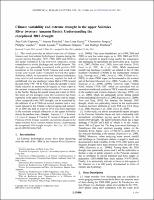Climate variability and extreme drought in the upper Solimões River (western Amazon Basin): Understanding the exceptional 2010 drought
Metadata
Show full item recordAbstract
This work provides an initial overview of climate features and their related hydrological impacts during the recent extreme droughts (1995, 1998, 2005 and 2010) in the upper Solimes River (western Amazon), using comprehensive in situ discharge and rainfall datasets. The droughts are generally associated with positive SST anomalies in the tropical North Atlantic and weak trade winds and water vapor transport toward the upper Solimes, which, in association with increased subsidence over central and southern Amazon, explain the lack of rainfall and very low discharge values. But in 1998, toward the end of the 1997-98 El Nio event, the drought is more likely related to an anomalous divergence of water vapor in the western Amazon that is characteristic of a warm event in the Pacific. During the austral spring and winter of 2010, the most severe drought since the seventies has been registered in the upper Solimes. Its intensity and its length, when compared to the 2005 drought, can be explained by the addition of an El Nio in austral summer and a very warm episode in the Atlantic in boreal spring and summer. As in 2005, the lack of water in 2010 was more important in the southern tropical tributaries of the upper Solimes than in the northern ones.








